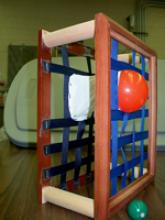
Our bodies are made up of trillions of cells, each of these cells is like a mini factory. In order to keep each factory in working order the cells needs a security guard to protect the factory. The security guard of a cell is its cell membrane.
In order to keep each factory in working order the cells needs a security guard to protect the factory. The security guard of a cell is its cell membrane. The cell membrane allows certain items into a cell and blocks others from entering, just like a security guard protects a real factory.
The goal of this demonstrate to show visitors that semipermeable membranes allow some materials to pass through but retain others.
Materials needed:
Microscale
- 3-L storage bottles containing:
- Red watercolor (A)
- Iron (III) chloride (FeCl 3), 0.1 M solution (B)
- Potassium thiocyanate (KSCN), 0.02 M solution (B)
- Potassium iodide (KI), 0.02 M solution containing iodine (C)
- 500-mL squeeze bottles for each of the solutions above
- Soluble starch, 0.05% suspension (C) in 500-mL squeeze bottle
- For each of 3 demonstrations (A, B and C):
- Semipermeable membrane (2.5" circumference dialysis tubing), about 6" long, fatened at bottom
- Beaker (150 mL)
- Squeeze bottle and gallon jug of tap water
- Paper towels
- Waste bucket
- 1-2 extra 6" pieces of membrane, soaking in water
Macroscale
- Rigid tube
- Flexible tube
- Objects of different sizes
Procedure
Set up
- Place 500-mL squeeze bottles with corresponding beaker containing membrane in order: Set A, Set B, Set C.
- Have paper towels, squeeze bottle of water and waste bucket available.
During the Presentation
- Briefly discuss what a semipermeable membrane is, e.g., pore size, size of particles that pass through, use as cell membrane and in kidney dialysis.
- Microscale: Explain that for the three tests (Set A, Set B and Set C), we will see by color changes whether particles went through in one direction, both directions or not at all.
Set A
- Water is outside the membrane (about 50 mL in beaker)
- Watercolor paint is inside the membrane (red color, membrane about 2/3 full)
- Tell visitors to look for color in the water if the paint can move through the membrane out into the beaker.
- Lower the membrane into the beaker and swirl. Lift out after about 10 seconds, then after 20 seconds of swirling to check for any color change in the beaker. (No color change.)
Set B
- FeCl 3 is outside the membrane (yellow, about 50 mL in beaker)
- KSCN is inside the membrane (colorless, membrane about 2/3 full)
- These two compounds can react to form an orange-brown complex.
- Ask for predictions if color change will occur inside the membrane, outside the membrane, neither or both.
- Lower membrane into beaker, swirl. Lift out after about 10 seconds, then after 20 seconds or swirling. (Both solutions should turn orange-brown to red-brown.)
- Confirm that visitors understand that this means particles were moving in both directions.
Set C
- Starch is outside the membrane (colorless, about 50 mL in beaker)
- Potassium iodide is inside the membrane (yellow, membrane about 2/3 full)
- The two solutions react to form a blue color.
- Ask for predictions if color change will occur inside the membrane, outside the membrane, neither or both.
- Lower membrane into beaker, swirl. Lift out after about 10 seconds, then after 20-30 seconds until blue color appears in beaker only.
- Confirm that visitors understand what this means.
Macroscale
Use the models provided.
a. Passive transport - Have visitors determine which objects go through the rigid tube.
b. Active transport - Have visitors determine which objects go through the flexible tube with squeezing (supplying energy), comparable to channels in the cell membrane.
Clean up:
- Between each presentation, empty membranes and beakers and rinse to remove color.
- When there is a break between presentations, soak the membranes in water. Leave in water overnight.
- Contents of the waste bucket may be put down the drain. Make sure all color is thoroughly rinsed off the sink or toilet bowl.
Explanation
Cells in the body are surrounded by membranes that permit or deny access in and out of the cell to particles such as ions and molecules. The cell membranes allow active transport by supplying energy to permit entrance or exit.
The kidneys act as filters to remove toxic substances and other waste or excess materials from the blood. When kidneys fail, kidney dialysis can perform this function using a semipermeable membrane (see hand-out).
What could go wrong?
- In filling the membrane, if any solution spills on the outside, it must be rinsed off to prevent sudden or unexpected color change.
- The soluble starch suspension in Set C needs to be aerated by shaking the 0.05% solution well each day to produce the blue color in a timely fashion. In addition, make up the diluted (0.05%) solution from the 0.5% stock solution every 5-7 days or as needed to produce a blue color within 15 seconds.
- Speed of color change is based on the relative concentration of the two solutions and the total surface of membrane. Changing the membrane diameter, beaker size, or volume of solutions may speed up or slow down the color change.
General Maintenance
- All solutions except starch may be prepared in bulk in 3-L containers and are stable for at least 3 months. Starch should be prepared as the 0.5% solution every 2 months and then diluted to 0.05% every 5-7 days.
- Each presentation requires approximately 20 mL for solutions inside the membrane (watercolor, KSCN and KI), for a total of 150 presentations for each 3 L.
- Each presentation requires approximately 50 mL for solutions in the beaker outside the membrane. For FeCl 3, 3 L is adequate for 60 presentations. For starch, each 300 mL of 0.5% stock solution is adequate for a total of 60 presentations (after portions are diluted to 0.05%).
Preparation of solutions
|
Solution/suspension |
Directions for preparation |
| Watercolor, Alizarin Crimson |
Place about 2.5 L of tap water into a large container. Add ¾ teaspoon (5.4 grams) of alizarin crimson and mix well. Add an additional 500 mL of water in portions, using this water to rinse the spoon and/or weighing dish, etc. Mix well. |
| Iron (III) chloride (0.1 M FeCl 3) |
Place 3 L of tap water into a large container. Add 6 level tablespoons (49 grams) of FeCl 3 and dissolve. Mix well. |
| Potassium thiocyanate (0.02 M KSCN) |
Place 3 L of tap water into a large container. Add 2 level teaspoons (6 grams) of KSCN and dissolve. Mix well. |
| Potassium iodide with iodine (0.02 M KI + I 2) |
Place 3 L of tap water into a large container. Add 2 level teaspoons (10 grams) of KI and dissolve. Add 1/8 teaspoon (1 gram) of I 2 and dissolve. Note : Complete dissolution of I 2 may require several hours. |
| Starch, 0.5% |
Place 1 level teaspoon (3 grams) into a 1-L container. Add 600 mL of tap water, bring to a boil with stirring, then cool to room temperature. Or Add 600 mL of very hot water (e.g., from a water cooler system that delivers hot water) and immediately stir for several minutes, then cool. (A small amount of starch may not dissolve.) |
| Starch, 0.05% |
Transfer 50 mL of the 0.5% starch solution to a 500-mL squeeze bottle. Add 450 mL of tap water and mix well. |
| EDTA (Disodium salt of ethylenediaminetetracetate) |
Place 1 teaspoon of EDTA in a 500-mL container. Add 480 mL of tap water and mix well to dissolve. |
Membrane maintenance
Prior to initial use, cut a piece of semipermeable membrane approximately 6” long, soak it in water for a few minutes and open it by gently sliding it back and forth between your fingers. (Do not allow to dry out as it becomes brittle and may tear.)
With gentle handling, the membrane should last for weeks. When it cracks or tears, discard it. Keep two new soaked and opened pieces of membrane on hand during presentations (see step a).
If the membrane becomes discolored (common with Set B), place it in about 30 mL of EDTA solution and heat in the microwave or on a hot plate. Microwave for 30-60 seconds (or bring to a boil). The membrane should change from yellow-brown to colorless or very faint yellow. Rinse the membrane and store in water.
Procedure Sheet: membranes_procedure.pdf
Membranes FAQs
Our bodies are made up of trillions of cells, each of these cells is like a mini factory. In order to keep each factory in working order the cells needs a security guard to protect the factory. The security guard of a cell is its cell membrane. The cell membrane allows certain items into a cell and blocks others from entering, just like a security guard protects a real factory.
Cool Facts
- Cell membranes are only 10 nm thick!!
- A cell membrane is 20,000 times thinner than a human hair!!!
- Your body builds cell membranes from cholesterol!!!
- Charged particles can move in and out of our cells through our cell membranes, this causes the membranes to generate a voltage, in an electric eel the voltage is large enough to kill a person!!! Luckily our cell membranes do not make such a large voltage.
A: Our cells have cell membranes to keep important things inside the cell and to guard against dangerous things entering our cells. That is why the cell membrane can be thought of as the security guard of our cells. It protects our cells!!
A: Cell membranes are a very thin wall that surround the inside our cells, you can think of them being like a fence around a yard. The cell membrane is made up of two layers of fat, the same fat that is in our food, with protein on top of and between the layers of fat.
A: There are three main ways our cell membranes allow things to cross inside of our cells diffusion, facilitated diffusion, and active transport. During diffusion molecules will be absorbed through the cell membrane into cells. The molecules that are allowed to enter the cells through this process are very small. If they are bigger they need to enter to using facilitated diffusion or active transport.
A: Facilitated diffusion works like a gate, the cell membrane acts as the gate keeper. When something that wants to enter a cell reaches a cell membrane and it can not enter via diffusion, a gate will open and allow the molecule to enter. The proteins that sit on the outside of the cell membranes act as the gates. If the same type of molecule needs to leave a cell the gate will open and allow the molecule to leave. Molecules will enter and leave a cell based upon the concentration of that molecule inside of the cell. If there is not enough of a certain molecule inside a cell the gate will open and allow a molecule to enter. If there is too many of a certain molecule the gate will allow some to leave.
Our bodies are made up of many cells, and the cell membranes protect our cells from things entering and leaving our cells. They help to provide our cells with the food it needs as energy by allowing important molecules into the cell. Cell membranes also keep out things that can harm our cells. The cell membranes may be small they are extremely important!!!

